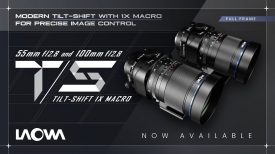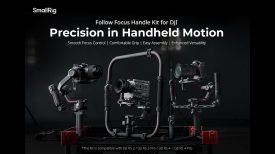By Newsshooter contributor Jonah Kessel.

It was only a few months back when Newsshooter.com editor Dan Chung said “My crystal ball says that before long most real world shooters will be using autofocus for some, if not all, of the time.” Dan’s prediction became one step closer today when Canon surprised us with a big upgrade for C100 users.
The new upgrade will make the EOS C100 Canon’s first C series camera to integrate Dual Pixel CMOS technology. This technology allows for continuous autofocus while using Canon EF lenses while also offering improvements with focus in relationship to movement and blur.
However, unlike with the release of the 70D, introducing this technology to the C100 makes the technology more applicable to professional shooters who demand more from their cameras than what a DSLR can offer.
I believe this technology has been targeted toward the C100 market first because the user group is more unified as real world shooters, opposed to C300 or C500 shooters who do a greater mix of corporate and commercial work where autofocus technology might not be as relevant. For documentary, news and real world shooters, the technology could have many uses.
For solo shooters simultaneously filming and conducting an interview, autofocus could help keep floating, antsy subjects in focus without having to have the documentarian distracted from the subject trying to continually change focus. With sports, events or real world scenarios with unpredictable actions, autofocus might decrease the need for a follow focuses. Shooting moving subjects or objects could be easier at shallow depths of field. From a business perspective, the technology will also make the C100 more competitive of a choice for people who may have gone towards a more traditional camcorder.
However, as an actual C100 user having used a 70D, I can’t say I am too excited to have it. However, my hesitation is mostly due to a lack of trust in the technology that can only come with experience using it. I do know that I will upgrade my camera immediately. The cost is only $500 and given the option you can just turn it off, it seems like a no-brainer to get the chip installed. Once the chip is installed, using an external recorder such as the Samari Blade, outputting a higher quality signal, my C100 will in many ways be more powerful than the C300 whose price is more than twice as much. How and weather I actually use the technology, is certainly yet to be determined.
Here is Canon’s release:

EOS C100 Feature Upgrade
Available soon from Canon will be a factory-installed upgrade for the EOS C100 Digital Video Camera that will offer an autofocus mode to prevent motion artifacts during rapid talent and pan moves. The upgrade provides a new Continuous AF (Autofocus) Function for all Canon EF Lenses, apart from manual-focused models, using Dual Pixel CMOS AF technology. A new AF Lock setting also lets you change the image framing while holding the desired focus point. These critical focusing capabilities are designed to enhance the smooth capture of moving subjects and achieve more natural-looking autofocus so users can meet their creative needs in even more situations.
How Does Dual Pixel CMOS Work?
The EOS C100 camera with Dual Pixel CMOS AF technology features a CMOS sensor that consists of an array of pixels that each feature two separate photodiodes. By continuously comparing their outputs during AF mode, phase-difference autofocus helps ensure non-blurred images even when the talent and/or camera are moving. The new feature places a high priority on image quality, providing a natural, smooth autofocus movement with all Canon EF lenses – including newer-generation STM lenses – offering quieter operation.
![]()
After this modification, the EOS C100 camera’s Continuous AF function in the middle of the frame represents just 20% of the overall frame in the vertical plane and 25% horizontally, the remainder being used to define the sharpest section of the image for tight, accurate video resolution even when the camera is moving. The AF Lock mode allows you to set the focus point and hold it, thereby making it possible to change framing while maintaining the same focus position.
Fast, Smooth AF During Video Capture
A modified EOS C100 camera’s set-up menu offers two options for “AF Mode” – One-Shot AF and Continuous Autofocus – with AF Lock also becoming an option for the camera’s assignable buttons. During filming, you simply press this button to prevent Continuous AF from changing, and then press it again to re-enable that mode.

The Dual Pixel CMOS AF technology helps provide smooth and consistent autofocus, so that pans are natural looking with subjects remaining focused even as they move. The compatibility of Dual Pixel CMOS AF with many Canon EF lenses combines outstanding optical tools with a wide range of creative options.
By using Contrast AF signals to supplement the EOS C100 camera’s new Dual Pixel CMOS AF, you may be able to avoid blurring caused by the normal inability to detect the direction in which the focusing circuitry should move to help ensure consistent focus.

Faster One-Shot AF Mode
The combination of Contrast AF and Dual Pixel CMOS AF helps ensure that autofocus adjustments will move in the correct direction, and not hit the end of its range and then have to change directions to locate the correct setting. As Contrast AF can now detect the correct focusing direction, thereby eliminating a random search, a modified EOS C100 will focus twice as fast as an unmodified camera, with a more natural look and no overshoot. Because the current One-Shot AF mode uses only Contrast AF, movements can be jerky with overshoot anomalies.

Faster One-Shot AF Mode
The factory-installed upgrade for the EOS C100 camera is targeted at users who regularly shoot moving subjects, or who want a smoother, more natural-looking autofocus feature. Specific markets include documentary filmmakers, electronic newsgathering, sports productions, weddings and similar special events, nature and wildlife, and many others.
Available February 2014
Canon USA will perform this feature upgrade at a cost of $500, and will require that EOS C100 cameras be sent to an accredited Canon service center. Shipping and handling charges also may apply. Additional details will be provided when the upgrade becomes available.
See Canon’s announcement here.
Jonah M. Kessel is a Pulitzer Prize-winning visual journalist and cinematographer based in Beijing, China. He covers China for the video desk of The New York Times and makes videos and photos for newspapers, magazines, multinationals, nonprofit and governmental organizations around the globe. He always wants to know what’s on the other side of the mountain, regardless of what side he’s on. See his site here or keep up with him on Twitter here.






